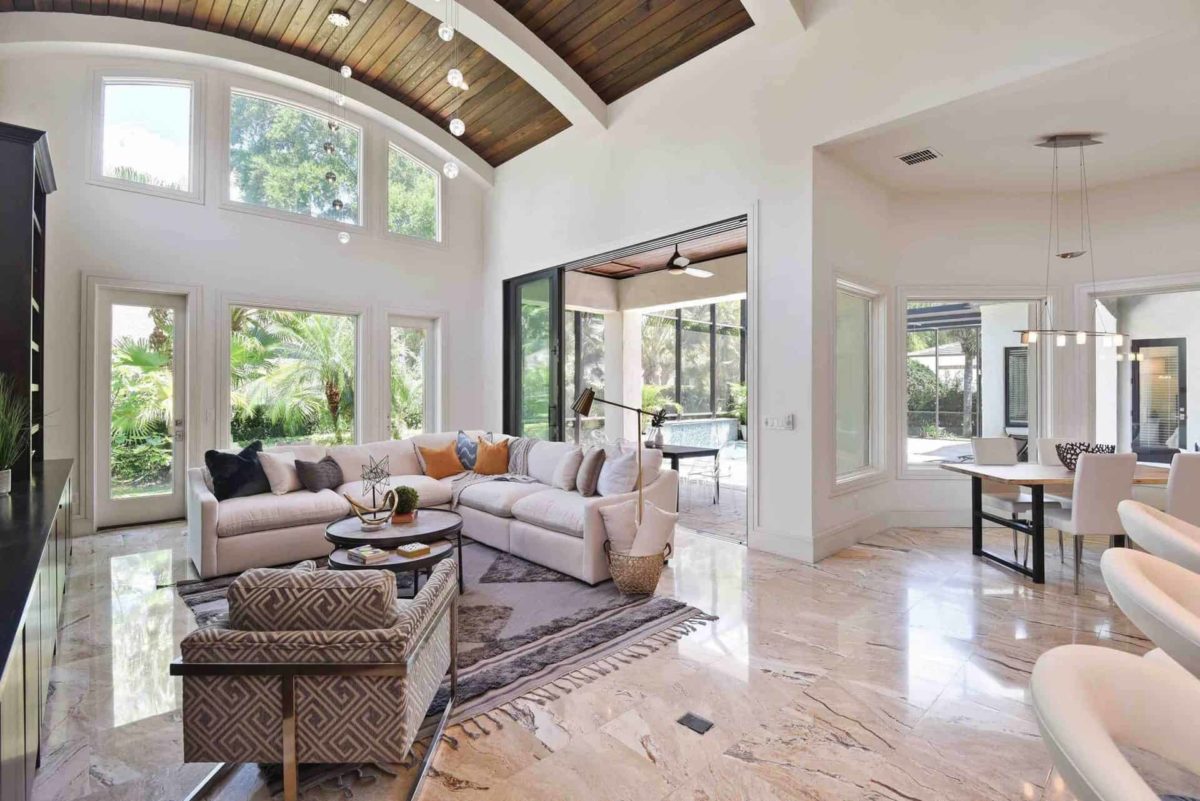Pattern in Interior Design: An Expert Guide
When decorating your home, you want all rooms to be cohesive and flow smoothly. However, creating that feel can be challenging, especially when you are talking about decorating and furnishing multiple rooms and spaces. Below are some tips to help you create a cohesive home that also reflects your design style. After highlighting some tips and tricks for using color and patterns throughout your home, we’ll then discuss specific types of patterns in interior design and how you can use each one to create a cohesive, eye-catching interior style.
Tip #1: Select your color palette ahead of time
You don’t need to pick just one color, you can pick multiple colors that are complimentary to one another, but make sure you have the color scheme nailed down before you start your shopping. It is helpful to keep the big furniture pieces neutral and the color can be incorporated through your decor. This can include colorful rugs, wallpaper, or other decor.
Tip #2: Use color repetition throughout your home
Incorporate your color palette in every room through either art, throw pillow, rugs, etc. If you have rooms that are closed off and “separate” from other rooms, that’s your chance to have fun with colorful patterns. Throw in some fun colors, but try to always have at least one item that goes back to your original color palette.
Tip #3: Use texture repetition throughout your home
If you have a leather sofa, try and incorporate leather in other rooms such as the headboard in your bedroom or a guest room. If you have linen pillows, use linen curtains as well. Repeating textures will also give your home a cohesive look and feel.
Tip #4: Metals and woods should have a buddy
You can absolutely mix metals and wood tones but if you do, make sure they have a “buddy” to match. For example, if you have a gold light fixture in the kitchen, make sure you incorporate gold elsewhere in the kitchen such as on the cabinet hardware or faucet. If you have a dark wood dresser in your bedroom, make sure you have at least one other piece of similar color wood somewhere else in the room.
Tip #5: Choose matching hardware
The hardware does not have to match throughout the whole home, but it should at least match in the room that it is in. So if you have black hardware on your kitchen cabinets, your faucet should also be black. If you have a silver faucet in the bathroom, the cabinet hardware should match and so on.
Tip #6: Decide where to place patterns
While wallpaper is a common place to add pattern in interior design, it’s certainly not the only option. You can incorporate patterns into every room in the house with things like furniture, rugs, throw pillows, soft furnishings, flooring, kitchen backsplash, table surfaces, wall lighting, and more. Whether it’s a patterned rug in the living room to patterned tile in the guest bath, the idea is to add something fun and exciting that compliments the more subtle, neutral colors you started with.
Types of Patterns in Interior Design
Using patterns in interior design adds visual interest and is a great way to add atmosphere and depth within your space. Interior designers even use patterns to play subtle tricks on the eye, whether it’s making a small room look like a larger space or even creating obvious directional movements through the home. For many homeowners, it’s about creating a space that represents their personal style, and for others, it’s about creating a warm, inviting space in the hopes of enticing potential buyers. But whether you’re selling a home or just looking to refresh your home’s interior design, incorporating pattern into your design concept can bring your interior space to the next level. Here are some common types of patterns and how to incorporate them into your design.
Vertical lines and stripes
Whether vertical or horizontal, stripes can be a very basic, yet elegant form of pattern to use in a room. It’s one of the most used design elements when an interior designer wants to create length or width to a space. Horizontal lines give the illusion of a larger space by making it look wider, while vertical lines add height and make it look like the room has a higher ceiling.
Geometric patterns
A geometric pattern would be any angle, line, or point that is displayed in a predictable visual order or repetitive manner. This pattern can be used with either two or three-dimensional structures. It’s surprisingly easy to to incorporate geometric patterns in interior design and it can really add a sense of calm within all types of styles – whether it’s contemporary, minimalist, or even vintage. Also, incorporating a design element that includes some sort of geometric pattern often produces obvious directional movements. In other words it can create a feeling of organized movement that’s very pleasing to the eye.
Complex patterns
A complex pattern is usually used in larger spaces because otherwise it can be overwhelming. The idea is to use various colors and diagonal or crisscrossing lines of varying sizes. Complex patterns can be a great way to liven up your interior design in a modern, sophisticated way.
Floral patterns
The best thing about floral patterns is that there are so many ways to use it in interior design. Create a focal point in the center of the room with a brightly colored floral couch or add a sense of calm with beige and white floral wallpaper. You’ll find multiple patterns everywhere you look, but be careful mixing too many floral motifs in one room. Stick to either a small pattern of delicate flowers or big and blowsy for a more extravagant look. Also, be sure to use the bigger patterns for larger spaces and save the delicate floral choices for a smaller area.
Abstract patterns
Also known as motif patterns, an abstract design on furniture, flooring, or the wall can add texture and fun to many different spaces. Use a large, intricate pattern on a large piece then add smaller pieces in the same abstract pattern throughout the room to add a sense of continuity.
Animal prints
If you really want to make a statement, animal prints could be just what you need to refresh your interior scheme. Interior designers usually incorporate a bold pattern like zebra or leopard print when it really meshes with the current styles of the day. However, if done right, animal prints can be a fun way to highlight a focal point in the room or just make it more luxurious overall. Consider statement pieces in a fun animal print or a bold pattern rug to really tie the room together.
How to Mix Patterns in Interior Design
The goal when using patterns in interior design is to add visual interest while still making the room feel cohesive and not overwhelming. Pattern choices play a huge part in this and by selecting patterns that compliment each other you can create an interesting space for all who enter. Here are some tips for mixing patterns:
Use similar or complimentary colors
To avoid a space that’s too chaotic, avoid too many patterns of too many colors. Instead, choose colors that are harmonious with each other or that are from the same color palette. Follow the 60-30-10 rule and make sure the space is 60% the dominant color, then 30% a secondary hue, and keep the remaining 10% a bold accent color.
Play with sizing
Sizing plays an important role when it comes to pattern choices. First and foremost, pick a large pattern that you can compliment with smaller prints. A large scale, dominant pattern is all the more interesting with a smaller pattern in complimentary colors. Use your large scale pattern on the largest thing, such as a statement wall with a boldly-patterned wallpaper. Then use the more dainty patterns for smaller elements throughout the room, such as throw pillows.
Mix Light and dark shades
Mix patterns that are light and dark and you will create a beautiful, contrasting effect. By using a mix of patterns that drastically show contrasting light and dark shades, you create a balance effect that is not only pleasing to look at, but it can also help you control where the eye is drawn to within the room. For instance, black and white tiles the bathroom floor or rug in the living room can create texture and depth to the room.
Blend simple and complex patterns together
Mixing pattern wallpapers or furniture pieces can create an eclectic look, but you have to be careful not to forfeit your cohesive design for a look that’s too overwhelming. Begin blending simple and complex patterns to see if they work together. For example, if you have a geometric pattern as the focal point, make sure the next pattern you use is a simple one in complimentary colors.
Know what patterns you shouldn’t mix
You don’t want patterns, colors, or textures that clash because then you have a space that’s downright off-putting. Choose a simple pattern or large patterns that go well together instead. Examples of patterns that don’t mesh include stripes and florals or ikat and polka dots.
Trust your eyes
A lot of interior design is trial and error. Start with less and keep adding pieces until you feel a visual balance beginning to form. Even if you are a beginner, exploring different design elements will enhance your own capabilities until you are able to choose patterns that flow nicely together. The more you learn, the more your eyes will be able to discern harmony and balance, ensuring that every element contributes to a cohesive aesthetic.
Choose your whites carefully
Neutral colors can make a great backdrop for large prints, but be careful when working with white. If your base color is white, make sure you’re matching everything else in the room with that shade. White can be a very calming background so mixing different shades of white can easily make the room feel unbalanced.
Follow the tone and direction of a pattern
This is specially important when using geometric patterns or certain abstract patterns in interior design. Diagonal, horizontal, or vertical – if your main pattern flows in a certain direction, try to maintain that direction with all other patterns. This can create a really cool look that feels symmetrical and organized.
Start from the bottom
If you have a few patterns in mind for a room, start from the floor and work your way up. By starting with the biggest part of the room ( the floor) and designing piece by piece until you reach the ceiling, it’s easier to make sure all patterns are in harmony with one another.
Now that you have a better understanding of how to use patterns in interior design, it’s time to start planning! And if you’re ever in doubt, don’t hesitate to contact a specialist.
At The Staging Company, we specialize in home staging and interior design to homeowners in Texas and Florida. We offer stress-free design services that can help you make more money when selling your home. Whether it’s fully furnished or an empty home, our huge warehouse of furniture, decor, and more makes it easy to find beautifully patterned pieces and more.

